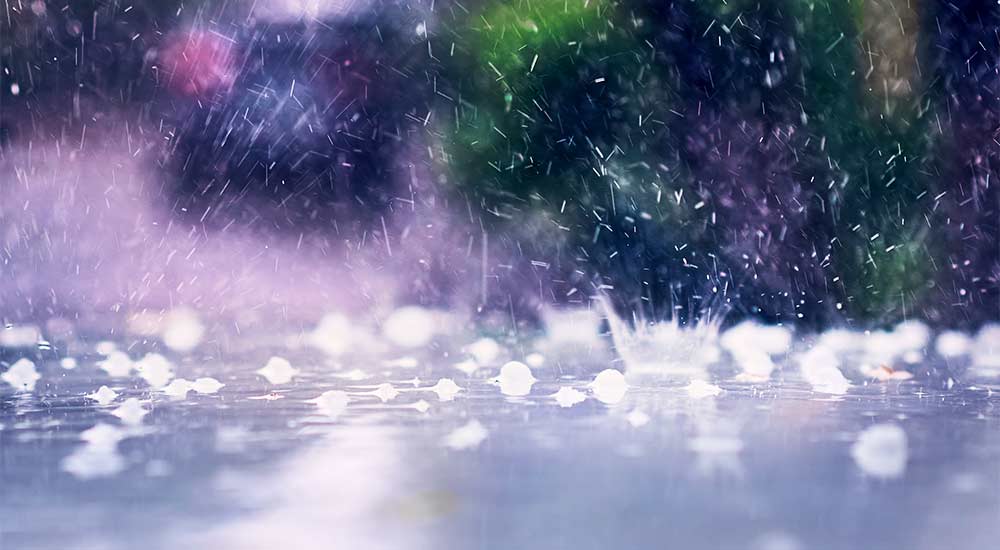How To Prepare My Business and Property for Hail and Wind in My Area

2023 saw 17 severe weather and hail events strike multiple regions across the country*. Hailstorms and strong winds are among the most destructive weather events, posing significant risks to both residential and commercial properties. By following these guidelines, you can minimize potential damage and ensure the safety of your property and loved ones.
Assessing Vulnerabilities
The first step in hail and wind preparedness is conducting a thorough assessment of your property's vulnerabilities. This involves identifying areas that are most susceptible to damage, such as roofs, windows, and exterior walls. For businesses, it is also crucial to evaluate the structural integrity of signage, outdoor equipment, and storage facilities.
Home Assessment
- Roof Inspection: Ensure that your roof is in good condition. Look for loose or missing shingles and consider installing impact-resistant roofing materials.
- Window Protection: Install storm shutters or impact-resistant windows to protect against flying debris.
- Exterior Maintenance: Trim trees and secure outdoor furniture to prevent them from becoming projectiles during high winds.
Business Assessment
- Structural Integrity: Inspect your building for any structural weaknesses that could be exacerbated by strong winds.
- Outdoor Equipment: Secure outdoor equipment and signage to prevent them from being damaged or causing additional harm.
- Inventory Management: Store valuable inventory in secure, indoor locations to protect against wind and water damage.
Creating an Emergency Plan
An effective weather safety and emergency plan is essential for both homes and businesses. This plan should outline the steps to take before, during, and after a hail or windstorm to ensure everyone's safety and minimize damage.
Home Emergency Plan
- Evacuation Routes: Identify safe evacuation routes and ensure that all family members are familiar with them.
- Emergency Supplies: Stock up on essential supplies, such as water, non-perishable food, flashlights, and batteries.
- Communication Plan: Establish a communication plan to keep in touch with family members during and after the storm.
Business Emergency Plan
- Employee Safety: Develop a safety protocol for employees, including designated safe areas within the building.
- Business Continuity Plan: Create a business continuity plan to minimize downtime and ensure that critical operations can continue.
- Insurance Documentation: Keep copies of important insurance documents and contact information for your insurance agent.
Strengthening Your Property
Taking proactive measures to strengthen your property can significantly reduce the risk of damage from hail and wind. This involves both structural upgrades and regular maintenance.
Home Strengthening Measures
- Roof Reinforcement: Consider installing roof straps or clips to enhance the structural integrity of your roof.
- Window and Door Reinforcement: Use impact-resistant materials for windows and doors, and ensure they are properly sealed to prevent water infiltration.
- Garage Door Bracing: Reinforce garage doors to prevent them from being blown in by strong winds.
Business Strengthening Measures
- Building Upgrades: Invest in structural upgrades, such as reinforced roofing and impact-resistant windows, to protect your business.
- Outdoor Equipment Protection: Use secure enclosures for outdoor equipment and ensure that signage is securely fastened.
- Regular Maintenance: Schedule regular maintenance checks to address any vulnerabilities and ensure that protective measures are in place.
Leveraging Technology for Safety
Modern technology offers a range of tools and resources to enhance preparedness and safety during hail and wind events. Leveraging these technologies can provide real-time information and early warnings, allowing you to take timely action.
Home Technology Solutions
- Weather Alerts: Sign up for weather alert services to receive real-time updates on approaching storms.
- Home Security Systems: Install home security systems with weather monitoring capabilities to receive alerts and monitor conditions remotely.
- Smart Home Devices: Use smart home devices, such as smart thermostats and flood sensors, to monitor and manage potential risks.
Business Technology Solutions
- Weather Monitoring Systems: Invest in advanced weather monitoring systems to track storm conditions and receive early warnings.
- Remote Monitoring: Use remote monitoring technologies to keep an eye on your property and receive alerts about potential threats.
- Data Backup: Implement data backup solutions to protect critical business information and ensure continuity in the event of damage.
Don't Forget Your Vehicles
When preparing for hail and wind events, make sure to protect your cars and trucks too.
- Garage Parking: Whenever possible, park your vehicles in a garage or covered area to shield them from hail and strong winds.
- Secure Parking: Park vehicles away from trees, power lines, or structures that could collapse and cause damage during high winds.
- Car Covers: Use car covers to provide an extra layer of protection against hailstones and debris during severe weather.
- Emergency Kits: Keep emergency kits in your vehicles with essentials like first aid supplies, water, blankets, and non-perishable food.
- Insurance Coverage: Ensure your auto insurance policy includes coverage for hail and wind damage to mitigate repair costs.
- Hail Blankets: Consider investing in hail blankets or protective coverings to shield your vehicles during hailstorms.
Preparing your home, business and other property for hail and wind requires a proactive approach and a comprehensive plan. By assessing vulnerabilities, creating an emergency plan, strengthening your property, leveraging technology and consulting with your insurance agent, you can significantly reduce the risk of damage and ensure the safety of your loved ones and assets.
*Source: Climate.gov
